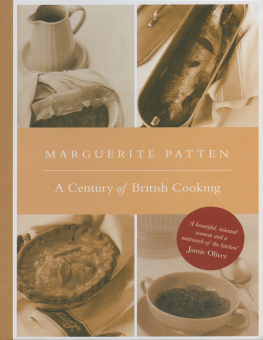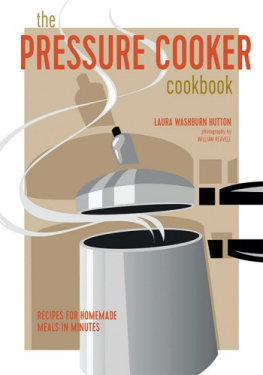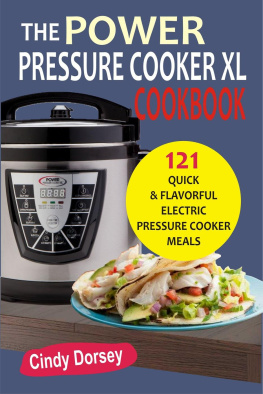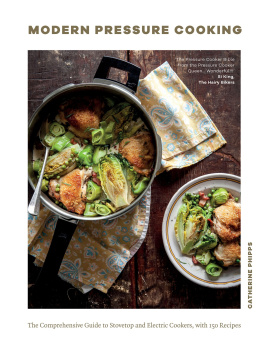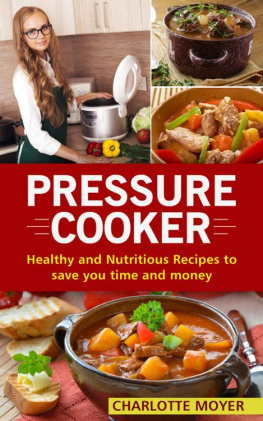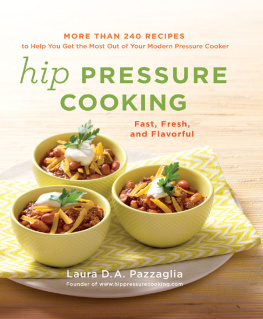
Published in 2010 by
Grub Street
4 Rainham Close
London
SW11 6SS
Email:
Web: www.grubstreet.co.uk
Text copyright Marguerite Patten 1977, 2010
Copyright this edition Grub Street 2010
First published in Great Britain by William Collins Sons & Co in 1977 as Marguerite Pattens Pressure Cookery
A CIP catalogue record for this book is available from the British Library
ISBN 978-1-906502-62-1
Digital Edition ISBN 978-1-909166-95-0
All rights reserved. No part of this book may be reproduced or transmitted in any form or by any means, electronic or mechanical, including photocopying, recording or any information storage and retrieval system, without permission in writing from the publisher.
Printed and bound in Great Britain by
MPG Books Ltd, Bodmin, Cornwall
This book has been printed on FSC (Forest Stewardship Council) paper
PUBLISHERS NOTE
The publisher wishes to thank manufacturers Prestige, Tefal and WMF for so generously supplying pressure cookers for testing and for allowing the publisher to reproduce information from their instruction manuals.
CONTENTS
INTRODUCTION
I was first involved with pressure cookers at a press launch in 1949 and so having enjoyed their benefits in my own home for over sixty years, I do appreciate the time and fuel they save in cooking.
Often I am asked just how I use the cooker. When I reply, I realize to what an extent I rely on it for so many cooking processes. You will find these described, with my own favourite pressure cooking recipes, in this book, but to give a brief indication of the versatility of a pressure cooker I list the main purposes below.
I hate wasting food of any kind, so bones, poultry and game carcasses are put into the cooker to produce a rich stock which gives the basis for interesting soups, stews and many savoury dishes.
Like many women today, I have a career as well as running my own home, and time is precious. It is a great relief to be able to produce an interesting main dish with beans, meat or poultry in a matter of minutes, not hours.
The British varieties of steamed pudding are famous, and deservedly so, for they are delicious and often very nutritious too. So why are they not made more often? I think it is because of the time needed to cook them and also the bother of filling up the pan under the steamer, and enduring the steam in the kitchen during the cooking process. You will find you not only save time in cooking the puddings if you use a pressure cooker, but you no longer have to worry about needing to replenish the pan with boiling water during cooking.
There are other important advantages. Rather elderly vegetables or cheaper cuts of meat, which might well be hard or tough, if cooked by conventional methods, can be made tender and full of flavour by this quicker method of cooking. You will notice I use the words full of flavour, for one of the pleasures of pressure cooking is to find you retain so much of the good taste of the vegetables, fruit, meat, etc.
There are certain dishes which often cause problems in cooking; among them I would list egg custards (both sweet and savoury). These need very careful attention to temperature and timing to ensure success. You will see that dishes based upon egg custards are cooked perfectly and simply in a matter of minutes.
Often people say that a pressure cooker must be a great boon to a large family; indeed it is, but it also enables a person living alone to cook a complete meal in the one pan, so saving both fuel and effort in washing up afterwards.
Most of us like to have a good store cupboard containing preserves of all kinds and most people today own a freezer. When making marmalades, jams, or preparing dishes for the freezer or for bottling, you will find your pressure cooker is invaluable.
I have stressed that I, like most people, hate wasting food, but I am sure you all agree with me that it is also important to save time and money. This you will do if you make full use of your pressure cooker. To produce a stew or soup in minutes, using one burner or hotplate only on a low heat, after bringing up to pressure, must be cheaper than using the same part of the cooker, or the oven, for several hours.
I think most families would say they require appetizing food at a price they can afford, and the kind of food which is easy to cook and which does them good.
This is why home cooking of good basic fresh ingredients forms a sound foundation for healthy eating. Over the years many scientific experiments have been carried out on the results of pressure cooking and it has been found that the food is not only good to eat, but retains the maximum of mineral salts and vitamins too, so pressure cooking can be described as a healthy form of cooking, as well as a speedy, fuel- and money-saving method.
Most women go out to work today, and they will find that so many recipes that were difficult to cook for the family in the evening, because of the prolonged cooking period, are now easily cooked within a short time. Planning well ahead means you can often pressure-cook extra vegetables, fruit, etc., for the next day.
People who live alone often say they cannot be bothered to do much cooking. I hope they will look at pages 52, 106-108 and 121, for on these pages there are suggestions for complete meals in the pressure cooker.
Baby food may seem a great deal of trouble, but often the special dish required for the baby or small child can be placed in the cooker and prepared with the family meal. This is covered within the book.
There are times when we all want something rather special, maybe for a special celebration meal or when we are entertaining. I am a great believer in perfecting a basic recipe, then finding ways to adapt this, so that it becomes suitable for all occasions, but never monotonous. Many of the recipes have a Gourmet Touch note at the end with recipe suggestions; these will enable you to shine as a sophisticated, as well as a wise and economical, cook.
I am confident you, and your family, will benefit as much as I have by using this method of cooking. I trust that the recipes and information in this book will be helpful.
Marguerite Patten
HOW THE COOKER WORKS
Although various models have their own particular features, the general principles are similar.
Until pressure is built up inside the cooker you have ordinary elegant utensils that look like saucepans. Indeed at times you will use the cooker just like an ordinary pan, e.g. when frying meat, vegetables, etc., for a stew; when thickening soups or stews at the end of cooking; after softening peel and fruit for marmalade, jams, etc.
Normally liquids boil at a temperature of 100C (212F). This temperature is controlled by atmospheric pressure and cannot increase, no matter how long boiling continues. If the atmospheric pressure can be increased, then the temperature at which liquids boil can be raised accordingly. This is the basic principle behind pressure cooking.
The ingredients, and liquid in which they are cooked, are enclosed in a safe, steam-proof vessel. This means the steam, which normally escapes into the atmosphere from an ordinary pan, is controlled and only allowed to escape under pressure. As you seal in steam, you then build up a higher pressure, which in turn produces a higher boiling point inside the cooker. This is the reason why foods are cooked so much more quickly and so efficiently.
Most modern pressure cookers have a choice of two pressures. This enables you to select the right temperature for various cooking processes and so achieve the best results. In all recipes in this book you will find the recommended pressure.
Next page

